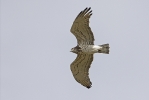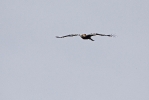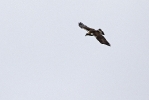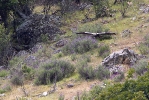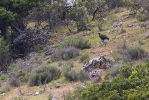Search in RaptorImages
Calendar
April 2024 M T W T F S S « Jan 1 2 3 4 5 6 7 8 9 10 11 12 13 14 15 16 17 18 19 20 21 22 23 24 25 26 27 28 29 30
The first six months of 2012
The winter and spring passed very quickly with extreme hard work, mainly in the office, unfortunately, but with interesting raptor conservation related consultancy at least. I am trying to summarize the more important photo events of the last five months below (Wintering Eagles, Spain!, Spanish Imperial Eagles).
Regards,
András
Posted in Nincs kategorizálva
Spanish Imperial Eagles
The Spanish Imperial Eagle (SIE – Aquila adalberti) is the closest relative of the Eastern Imperial Eagle (EIE – Aquila heliaca). Actually, the two species were separated only in the 1990s. Today they are thought to form a so called superspecies.
The Spanish Imperial Eagle is probably the rarest Aquila species of all. Its breeding population is restricted to the Iberian peninsula, mostly to Spain, with a few breeding pairs in Portugal.
The Spanish breeding population of the Spanish Imperial Eagle have increased more than eight-fold since the mid-1970s and reached 300 breeding pairs in 2011 (38 pairs in 1974 and 317 pairs in 2011) due to positive environmental changes and the outstanding Spanish raptor conservation and research projects.
To me the highlight of our Spanish trip was obviously the Spanish Imperial Eagle. We were lucky enough to observe SIEs five times during less than 4 field days.
We spotted the first bird, a 2nd year eagle near the hilltop built village Alhambra in Castilla-La Mancha as it was slowly gliding and scanning the area fro food.
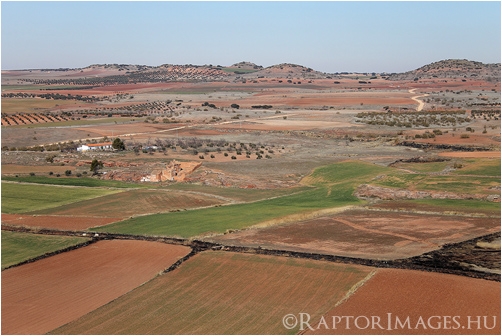
We tried to get closer to it, Nick drove up to the village but the bird had disappeared by then. We stayed on the excellent lookout and were watching the raptors around when the eagle suddenly re-appeared and practically came to us and started circling over.
I insert here a comparative pair of images with a juvenile-plumage Eastern Imperial Eagle.

The difference is quite obvious; the body feathers of the young Spanish Imperial Eagle are almost homogeneous tawny or rufous from below, while in the Eastern Imperial Eagle they are sandy- or buff-coloured and streaked on the upper breast and flank creating an apparent contrast to the pale belly, vent and thighs.
In a territory we could watch an adult SIE pair for a longer time. They showed quite aggressive territorial behaviour to Ravens and mated on a rock in an extremely dry, short-grass basin and roosting there calmly later at dusk (see New images gallery).
We saw an adult female SIE from a likely nearby breeding pair on one of the most popular tourist spot of the Monfragüe NP, the Pena Falcon.
At the end of the trip we found a distant, possible subadult SIE and in another area a 2nd cy SIE hunting in a company of a Golden Eagle. It was interesting to see these birds in an intensively managed agricultural habitat.
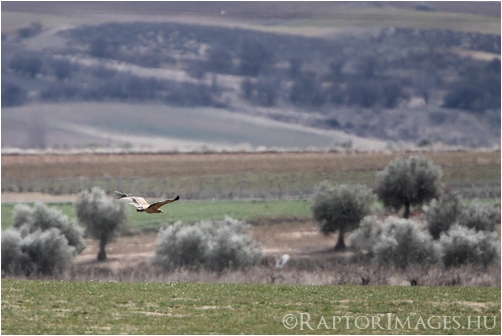
All in all, it was great to watch again Spanish Imperial Eagles.
Best regards,
András
Posted in Nincs kategorizálva
Turkey and the Imperial Eagle
Andris has already posted about the research of the Imperial Eagles in Turkey and the 6th expedition he participated in. This spring (2012) I had a chance to join the field team again since Marci couldn’t being too busy with other matters. We spent 9 days in Turkey and a few more in Bulgaria helping out the staff of the BSPB.
The plan was quite simple: to survey certain areas stood out by the data coming from bulgarian satellite tagged birds. In the most important of these areas there was already a sole observation of a displaying adult IE from an earlier trip. Surely it was enough to presume a breeding population. We eventually found 10 new territories and 6 nests in this basin. Unfortunately there was no time to search the whole area but most likely some new pairs will turn up during the next trip this summer. Though only the next trip will reveal data on the diet composition of the eagles it was interesting to see how dense the population of the Anatolian Ground-Squirrel was in some side walleys. No wonder why we found 2 occupied nests about 2 kms away from each other here.
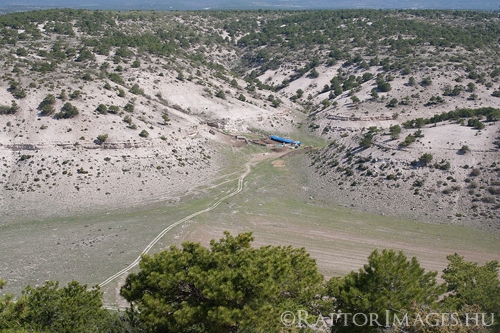
Narrow side-valley with extreme density of sousliks
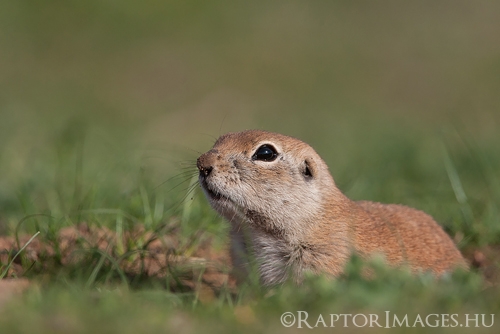
Possibly the main prey species of the IEs, the Anatolian Ground Squirrel (Spermophylus xanthoprymnus)
Beside surveying the basin mentioned before we also took some side-trips to other areas frequented by the sat-tagged eagles. With one exception these were probably good wintering areas but not for breeding lacking suitable trees. The one I mentioned before was a real gem, though. We stopped here to have a lunch-break and realized that there is everything an eagle can ask for: food (sousliks) and nesting substrate. Shortly after an adult IE showing up clearly proved that our hypothesis was “scientifically” sound.
On the way back to Bulgaria we drove through some mountain ranges of the Central Anatolia Region and stopped anywhere seeing good habitat for the species. These tactics seemed to be a winner again. We could add 3 more territories to the list.
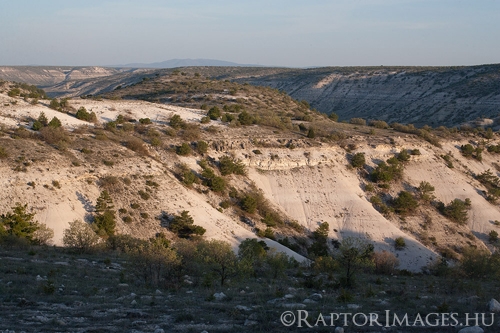
Typical breeding habitat of the IEs in the region (Eskisehír)
Our final turkish raptor-list tallied 25 species including some good observations like the adult Steppe Eagle or the territorial Lanner. (Keep in mind that the trip was only about the IE)
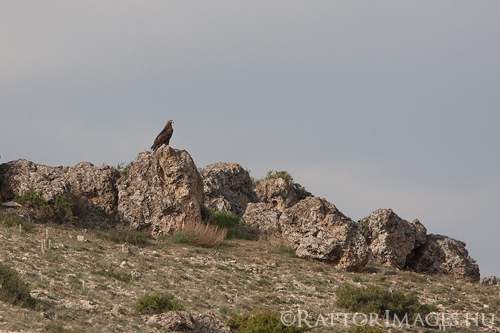
Ad. Steppe Eagle ( Aquila nipalensis)
During our stay in Bulgaria Tibi Juhász placed some artificial nest on trees found by the BSPB-staff (Mitko and Dobri) and we also did some observation in some promising territories with them but no luck this time. (Actually some kind of a bad luck had kept hunting us since we drove through the turkish-bulgarian border..)
The members of the field-team: Tamás Szitta, István Béres, Tibor Juhász and me.
If everything goes as planned we will report the findings of another IE survey in July.
Gábor
Posted in Nincs kategorizálva
Spain!
In the second week of last February I attended the Science Meeting of the EURAPMON project (www.eurapmon.eu) in Murcia, Spain.
After the workshop we took the opportunity and spent a few days in the field with Nick P. Williams watching and photographing raptors in Castilla la Mancha and Extremadura.
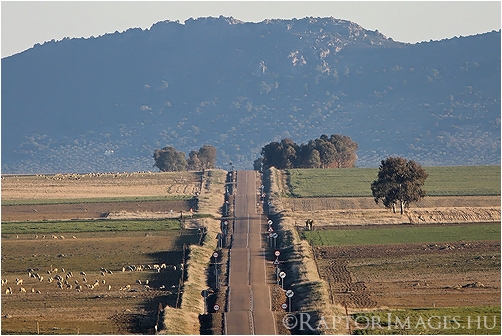
Spain is beautiful, the Spaniards are fantastic and on the top of that, the raptor fauna of Spain is truly amazing!
I have never visited Spain in early February before, so I didn’t have previous experience regarding the occurrence of birds of prey this that time of the year. I had been busy preparing for the workshop and we had not decided the field programme till we arrived in Spain. To cut it short, I couldn’t plan or search for details of the field trip. I missed Spain much, so I knew I would enjoy myself wherever we go and whatever we see as for raptors.
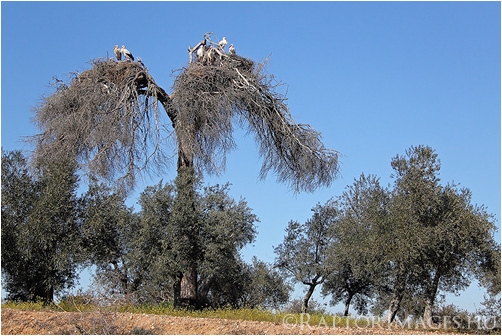
McDonald's supports the Spanish stork conservation programme with special nest platforms
“Do not expect too much and you will be satisfied” – this always works. Naturally, we saw a lot of raptors…
Nick - as a falcon fanatic – is a perfect fellow on a raptor trip. His ID skill is fantastic, his enthusiasm is endless (if there are raptors around), he is inexhaustible and his English sense of humour hits taboos quite often… It’s even better if the daily falcon dose is readily available…
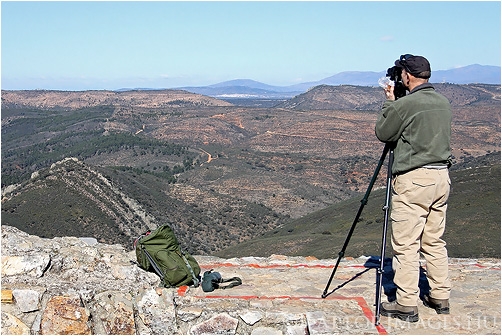
Nick in Monfragüe National Park
We observed the following raptors during the trip:
Griffon Vulture Gyps fulvus – several hundred, few hundred in the Monfragüe National Park during one day,
Cinereous Vulture Aegypius monachus – in low numbers, but seen regularly,
Egyptian Vulture Neophron percnopterus – we saw it only three times, once a displaying pairs,
Golden Eagle Aquila chrysaetos – on 8 occasions, once a displaying male,
Spanish Imperial Eagle Aquila adalberti – 5 occasions a total of 6 individuals,
Red Kite Milvus milvus – common wintering species,
Black Kite Milvus migrans – we spotted only one wintering individual,
Black-shouldered Kite Elanus caeruleus – one adult bird near Monfragüe NP,
Marsh Harrier Circus aeruginosus – common species on migration,
Hen Harrier Circus cyaneus – we saw a couple of birds every day,
Common Buzzard Buteo buteo – as its name,
Eurasian Kestrel Falco tinnunculus – common,
Peregrine Falcon Falco peregrinus – we swa only one pair in Monfragüe NP,
Merlin Falco columbarius – a total of 7 individuals were seen.
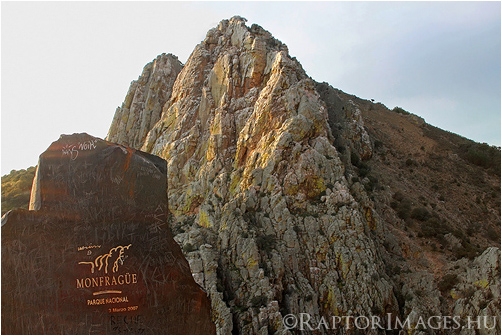
- Monfragüe NP, Pena Falcón
Many thanks to the participants of the EURAPMON workshop for the successful and enjoyable event and to the organizers for their kind hospitability.
A very special thanks goes to Nick for the excellent company and for all his help he provided during the fantastic field trip and photographing raptors!

Nick in the 7th (°C) Merlin Heaven
I uploaded a set of selected images into the New Images gallery.
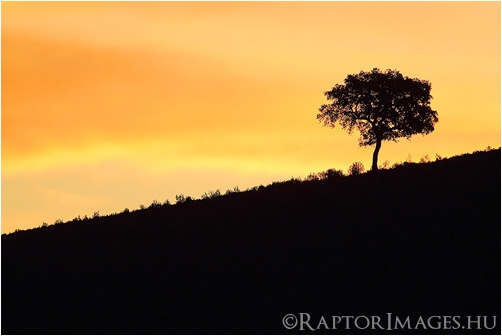
Regards,
András
Posted in Nincs kategorizálva
Wintering Eagles
In January I took a chance on a place, which used to be one of the top three temporary settlement areas for young and immature Eastern Imperial Eagles (EIEs) and White-tailed Eagles (WTEs) one decade ago. The number of wintering eagles has decreased significantly since then, but they still can be seen every day in the area.
Excellent place, although the days I spent there in the last years did not bring much result but some less seriously frozen toes in the hide.
Fortune was on my side at the end of last January and February, I could manage to take closer shots of three different WTEs and two EIEs.

In the latter two, the birds were in their 3rd and possible 4th plumages, which are comparatively rarely observed age classes, therefore high quality photo series are also relatively scarce of them.
The eagles were beautiful, watching and photographing them was really uplifting, hope you will enjoy the images too.
I wish you similar great experiences!
Best regards: András
Posted in Nincs kategorizálva
Christmas Greetings
We wish all our dear Visitors Merry Christmas and a Happy New Year!
András & Gábor
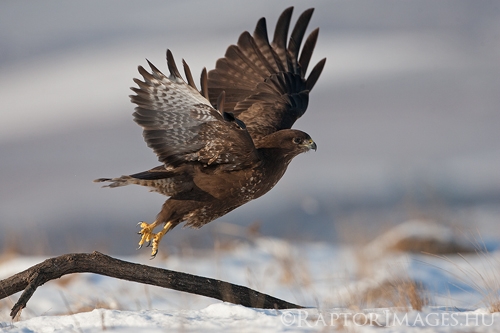
Posted in Nincs kategorizálva
ID pitfall #2: Common Buzzard – Long-legged Buzzard
After the previous post comparing the Common Buzzard with the Rough-legged Buzzard here is another possible ID pitfall: a juvenile Common Buzzard and a juvenile Long-legged Buzzard.
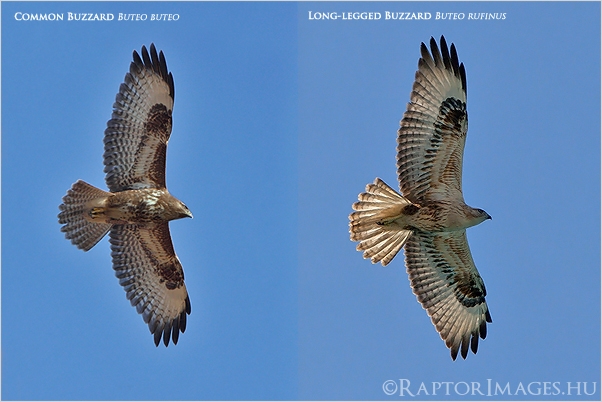
The picture shows the size difference between these two species as it is in reality, so the Common Buzzard is obviously smaller. Checking the wing-body proportions one can conclude, that the Long-legged Buzzard has longer and a bit narrower wing than that of his relative.
Notable plumage characteristics are the difference in the tail barring (CB > 6-8 bars, LLB < 6 bars), the presence of the blackish carpal patch on the underwing of the Long-legged Buzzard. Although the Common Buzzard also has dark carpal area, it’s normally not very striking because of the dark underwing coverts (median,lesser coverts). The contrasting dark thighs and the cinnamon tone to the body of the Long-legged Buzzard are also important ID features. Kéép it mind that the Common Buzzard can have reddish coloration int he plumage especially int he tail (I don’t deal with the ’vulpinus’ form since it’s quite rare in Hungary).
The strictly protected Long-legged Buzzard has become a regular but rare breeder in Hungary.It nests primarily in the Hortobagy region and the southern part of the Great Hungarian Plain but the numbers of wandering birds during summer and winter have been also increasing. This species can easily become collateral damage if the control of Common Buzzards turns legal. Even killing a few birds can be fatal to the local population.
We hope this example proves it again to everybody how hazardous the envisioned raptor control would be and also that it was help to anyone looking for ID help differentiating these two species of buzzards.
Regards,
Gábor and András
Posted in Nincs kategorizálva
Autumn voles bring buzzards
In spite of the drought dense populations of field voles emerged by November in unploughed fields, grassy field margins and fallow-lands on the Heves Plain. This is well shown by the relative high density of wintering Buzzards and Harriers.
The plumage variety in the Common Buzzard is infinite, individuals with very different plumage colours and patterns can be seen this time of the year.
I could take photos of a young Rough-legged Buzzard (RLB) earlier this week. It had a very similar appearance to the young pale Common Buzzard (CB) I had photographed recently.
I put together their images in order to show you the differences between their plumages.
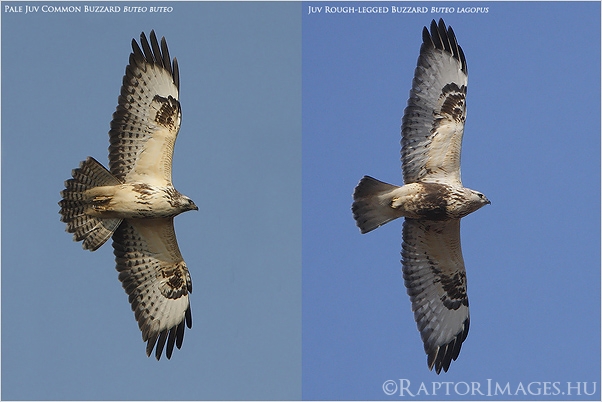
The colour and pattern of the underwings of the birds are confusingly similar.
However, due to the wide dark tips of the remiges and the more intensive barring of the secondaries the underwing of the Common Buzzard looks somewhat darker. Similarly, the tail also looks darker in the Common Buzzard. There are marking differences in the pattern of the head, breast and especially of the belly forming a dark brown patch in the young RLB.
Although, the angle of the wings of the birds differs a bit resulting in a narrower wing look in the RLB, the much longer wings of the RLB can clearly be seen.
Let’s talk about a recent threat connecting to this image.
There is a recurring proposal of the Hungarian hunting community on the control of the Common Buzzard and Marsh Harrier populations pleading their negative effects on small game populations.
This proposal is now supported at high political levels and would downgrade these species’ conservation status and permit their legal shooting and killing.
This presents an extremely narrow and poor view on a complex ecological system in which several environmental and anthropogenic factors’ cumulative effect define the population size of the small game populations rather than two highlighted birds of prey species. A real “end of barrel” solution!
It is obvious for everyone who completed secondary technical education that the size and viability of small game populations do not depend exclusively on two raptor species picked up from the predator guild and feeding mainly on rodents anyway, but rather on the general quality of available habitats.
So, efforts should be made on to increase habitat availability and quality for small game species instead of killing more animals.
Putting it all aside, I would take my hat off to those hunters who would be able to ID the Buzzard above without binoculars and define within seconds the one which can be shot.
If the Common Buzzard and Marsh Harrier were permitted to be shot legally many specimens of confusion protected and strictly protected species (Honey, Long-legged, Rough-legged Buzzards, Booted Eagles and Montagu’s, Hen and Pallid Harriers) would be shot in the future too. Simply because most hunters are not able to separate these species.
The control of these raptors is therefore completely unacceptable and entirely against Hungarian and European nature conservation traditions and legislation in force.
Hope this will not happen!
I uploaded some images of Buzzards and Harriers into the New Images gallery.
Cheers,
Andras
Posted in Nincs kategorizálva
Kazakhstan 2011 – trip report
I have to apologize to all those who were already looking for the kazakh trip report I had promised this past summer. Now I’m trying to make up for this.
If I had to summarize Kazakhstan raptorwise I would say that it is a must for any raptor fan. Since- except a short trip to the Tian-san- I had worked in semi-desert habitat between north of lake Balkhash and lake Alakol- mostly within a circle of 30-40 km radius- this report will refer to this area.
I had spent 2,5 months from April through June 2011 participating in an international project. Although our main target species was the Macqueen’s Bustard (Chlamidotys macqueenii) we had collected data on basically all bird species occured in the area. This short summary consists of all the data of nests and territories of raptors compiled by 10 field teams (2 people/car). I also included my personal impressions.
I listed the species in taxonomic order and I also included a few pictures of the region for our Dear Visitors to imagine easier in what habitat these species breed in this marvellous country.
1. Osprey (Pandion haliaetus): 1 ind. on migration in April
2. Oriental Honey Buzzard (Pernis ptilorhynchus): Only on migration between early May and mid-June. Max. 16 birds/ day.
3. Western Honey Buzzard(Pernis apivorus): 1 bird on May 8.
4. Black-eared Kite (Milvus migrans lineatus): One of the most common breeding and migrating species of raptors in the area. It was migrating between April and mid-May with the daily max. of 150 birds. The local breeders laid the eggs in the second half of April.
5. Pallas’s Fish Eagle (Haliaeetus leucoryphus): 1 ind. (2cy) on May 21. It was the bird of the trip for me. As far as I know there hasn’t been a proven case of breeding for decades and it’s a quite rare visitor anyway.
6. White-tailed Eagle (Haliaeetus albicilla): We only saw single birds (2 adults, 1 immature) probably migrating or just wandering about.
7. Himalayan Griffon Vulture (Gyps himalayensis): 7 birds in the Tian-san on June 23.

Extensively used pastures with high cliffs in the background suitable for nesting. That’s all what different vulture species and Golden Eagles need to breed.
(8. Griffon Vulture (Gyps fulvus): On May 8th 5 birds were soaring together with 3 Black Vultures (Aegypius monachus) but very far away and I couldn’t ID them to be 100% sure)
9. Short-toed Eagle (Circaetus gallicus): From May through June we observed 4-5 immature birds (probably 2cy) in the steppe. My ukrainian colleague Sergey Domashevsky found a nest with egg on a saxaul tree (Haloxylon ammodendron) at the height of 3m.
10. Hen Harrier (Circus cyaneus): A few migrating females and immatures in April.
11. Pallid Harrier (Circus macrourus): The most common breeding raptor species in the region. After the completion of our expedition we made a quick calculation to found that there were more than 40 pairs breeding here. During mid-April you could see displaying males everywhere which activity stopped with the start of the egg-laying season.

The kazakh steppe. The Pallid Harriers and Short-eared Owls were very common in this kind of habitat.
12. Montague’s Harrier (Circus pygargus): There were about 3-4 pairs in our study site but we could only locate territories but no nest was found.
13. Marsh Harrier (Circus aeruginosus): We only saw females and immatures migrating in April.
14. Shikra (Accipiter badius): We found 3 territories. All were int he same habitat, in riparian forests. I also heard about a pair probably breeding within a small village in a patch of trees.

Riparian habitats and saxaul forests are the only places where there is tree vegetation in this region. Black-eared Kites, Booted Eagles, Shikra were among the breeding raptors here.
15. Eurasian Sparrowhawk (Accipiter nisus): It was a quite common migrating raptor. The daily max was 10-15 birds. They migrated always alone.
16. Northern Goshawk (Accipiter gentilis): 3-4 birds migrating, all being immatures (2cy).
17. Steppe Buzzard (Buteo vulpinus): Rare migrant. We only saw a few birds in May.
18. Long-legged Buzzard (Buteo rufinus): Besides the Pallid Harrier and the Black-eared Kite it was the most numerous breeder. More than 30 pairs were found and out of these at least 3-4 pairs had one of the birds a dark phase one. There was no pair consisiting of 2 dark birds.

Long-legged Buzzard nest close to a small river.
19. Rough-legged Buzzard (Buteo lagopus): 1 adult male in the steppe on April 18th.
20. Steppe Eagle (Aquila nipalensis): The most widespread of all the ’Aquila’ eagles. About 15 pairs were nesting in the study area. Besides the local pairs one could see floaters basically everywhere (3-4 birds/day). Apart from the odd occasions of pairs nesting in totally flat habitat they normally chose hillsides with some rocks to put the nest on. Interestingly there was only one observation of displaying eagles.

During the egg-laying period the females were very tame. I experienced the same in Mongolia. Decorating the nest with garbage is common here too.
21. Imperial Eagle (Aquila heliaca): We observed one adult pair but no nest was found. This species was scarce with no more than 5-6 observation of single birds and once 2 birds together. These were exclusively 2-3cy individuals.
22. Golden Eagle ( Aquila chrysaetos): On 2 occasions we saw 1-1 birds and once an adult (probably) female.
23. Lesser Kestrel (Falco naumanni): The first birds occured at the breeding sites around the end of April. These places were normally abandoned military buildings, hangars. No colonies were found only 2-3 pairs together.

Old military hangars from the Soviet era. 2 pairs of Lesser Kestrels were breeding inside.
24. Kestrel (Falco tinnunculus): It was more common than the previous species. Regurarly occupied the nest of the Long-legged Buzzard.
25. Merlin (Falco columbarius): We saw them migrating in April and the first half of May with the max. of few birds/day.
26. Hobby (Falco subbuteo): The first birds arrived early May. Only a few pairs bred int he area.
27. Saker (Falco cherrug): The biggest and saddest surprise of all the raptors. All in all 3 breeding pairs were found and no or just one or two wandering birds were seen. At one of the breeding cliffs there was an obvious track going up to the nest as the sad proof of being well visited in the past. The only bird I saw was very similar to the birds live in Mongolia.

Although this year only Long-legged Buzzards were breeding on this hill in the background last year it hosted a pair of sakers and a pair of Eagle Owls (Bubo bubo) too.
28. Peregrine (Falco peregrinus): No breeding record from the area but a few birds were observed int he steppe.
Posted in Nincs kategorizálva

